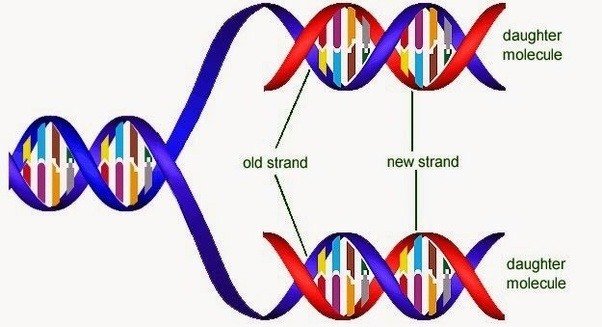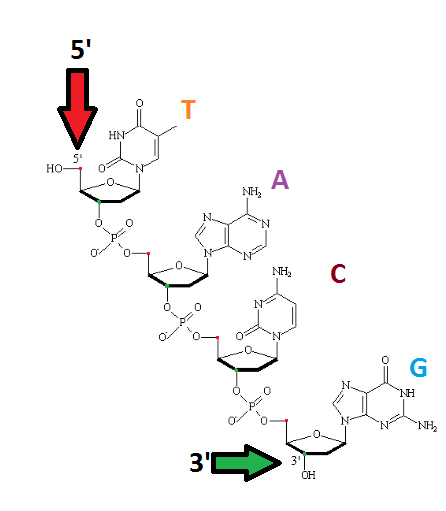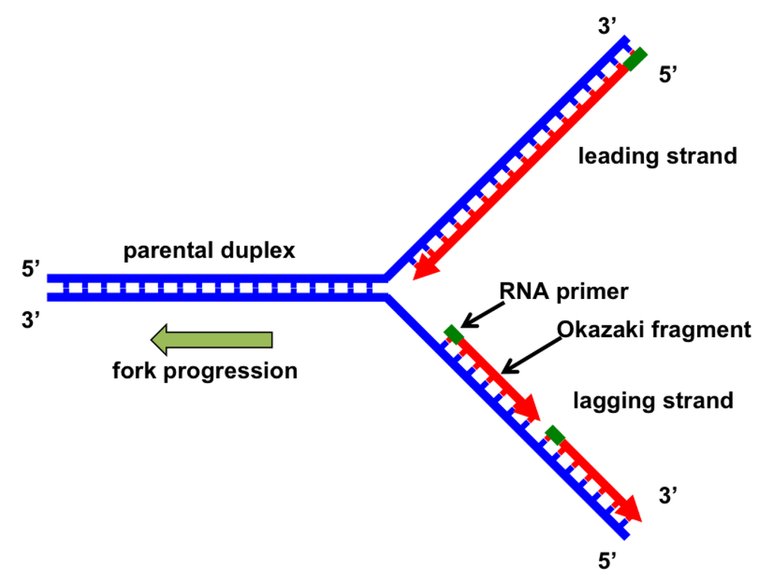Each time a new cell divides, the entire genome must be replicated in an error free manor in order to prevent cancer from arising. With around 3.2 billion base pairs in the human genome, this is no easy task, and errors do inevitably occur. DNA replication itself does have mechanisms to proof-read the replication process and minimise this error count. But there are also DNA repair mechanisms that can specifically repair mutations in DNA.

DNA is replicated in a process known as semi-conservative replication. All this means is that each of the two strands of DNA act as a template to produce the other. The result of semi-conservative replication is two strands of DNA each containing one new strand and one old strand of DNA.

figure 1. Semi-conservative replication
How is replication initiated?
Obviously, to begin replication the two strands of DNA must be separated to expose the nitrogenous bases of DNA to act as templates. Firstly, an enzyme known as the origin recognition protein creates a small opening in the DNA at the origin of replication (hence the name). Then an enzyme, known as DNA helicase, unwinds the DNA further to create a replication fork (shown in figure 1). The replication fork is stabilised by a protein known as single-stranded binding protein.
How are nucleotides added onto the template strand?
The enzyme DNA polymerase is able to add nucleotides together to create a growing chain of DNA. But, DNA polymerase can only add on nucleotides if one is already present, and it can only add them onto the 3’ end. This ultimately means that DNA replication can only progress in the 5’ to 3’ direction (annoyingly complicated ways to describe to direction of DNA) shown in figure 2.

figure 2. Directionality of DNA
This presents two problems for our DNA replication machinery. Luckily biochemistry was able to defeat them both!
Firstly, if DNA polymerase can only add nucleotides onto other nucleotides, how does DNA replication start?
Fortunately, this a fairly straightforward to overcome. A primer consisting of RNA (much like DNA except with a ribose as opposed to deoxyribose sugar) is laid down at the origin of replication. This is supplied by an enzyme known as a primase.
The second problem is slightly more complicated to understand and to overcome. It arises because DNA polymerase can only operate in the 5’ to 3’ direction.

figure 3. DNA replication fork
As can be seen from figure 3, this does not present a problem for the top red strand (known as the leading strand) because DNA replication is occurring in the same direction as the replication fork is opening.
The bottom red strand, called the lagging strand, is another story. It is being replicated in the opposite direction to the progression of the replication fork (remember DNA polymerase can only work in the 5’ to 3’ direction). This results in a segment of unreplicated DNA growing behind the replication fork. This problem is conquered by having continual re-initiation of DNA by inserting multiple primers as the replication fork proceeds (shown as the green in figure 3). This gives fragments of DNA and primer which are named Okazaki fragments.
Unfortunately, by solving one problem we have introduced another! Now we have a DNA strand with segments of RNA primer contained within it. Fortuitously, another enzyme is able to recognise the RNA fragments and simply replace them with the appropriate DNA nucleotide. After the primer is removed and replaced with DNA, a further enzyme known as DNA ligase seals the nucleotides into position by chemically bonding them together. Replication is now complete, we have formed two new (hopefully) identical strands of DNA from one original strand.
How does DNA polymerase know which nucleotide to add to give the correct sequence?
This is the last question we need to answer to fully understand DNA replication, yet it is the simplest. This all lies within the properties of DNA itself. There are 4 bases within DNA, adenine (A), guanine (G), cytosine (C) and thymine (T). Due to the shape and properties of each base, one is only able to fit opposite the other. Adenine can only base pair with thymine and cytosine can only base pair with guanine. This means DNA polymerase will only be able to fit a thymine opposite an adenine base and a guanine opposite a cytosine base. In this way, each of the original DNA strands act as a template for the new strands.
Great, we’ve understood DNA replication, but why should I care?
Understanding the biochemistry of DNA replication has implications in diagnosis, prognosis and therapy. Many new chemotherapeutic agents are directed to components of the DNA replication machinery in order to selectively kill actively dividing cells and efforts are underway to make those compounds selective for cancer cells.
References:
https://www.ncbi.nlm.nih.gov/books/NBK21134/
https://www.quora.com/What-is-the-importance-of-semiconservative-replication-of-DNA
https://en.wikipedia.org/wiki/DNA_replication
Gifs
Nicely elobrated and written in much simpler language, although, DNA replication is highly complex process...Kudos to the Author.
DNA helicases, Polymerases, Nucleotides and -sides Leading, Laging strands, Okazaki Fragments...Wow!!! You literally took me back in my biochemistry class of my 1st yr dental school and Pre-medical Lectures... Cell Biology used to be my Favorite topics coz it always fascinated me, how a small cell would do such complex processes and that too with such high precision. Due Upvote and Much earned Resteem.
Thank you very much. I just finished first year so all of this is content is relatively new and fresh to me. It is amazing how these complicated processes within the body are able to function with such a high efficiency.
Amazing...and that is what i like about our body...its administrative work is flawlessly beautiful.
What is even more amazing to me is that so many very intelligent people who owe their existence to the power and accuracy of our DNA believe that this super complicated self repairing and self replicating code just appeared on earth by random chance.
Evolution can really be thought of as chance manifest over long periods of time.
Hundreds of millions of years of evolution leads to 'unlikely' outcomes like this just as monkeys on typewriters would unwittingly write 'unlikely' literary masterpieces if given enough time!
You have a lot of faith in things that are illogical on the face of it and that you can not see nor prove.
I hear this a lot about what I believe and who I have faith in. ;)
Well done! I appreciated the hyper-link to your last month post on DNA repair mechanisms because just when I was wanting to know that answer, I realized it was a hyper-link :)
Thank you, I am glad that you found both of the posts useful and informative!
Steemit Education! Great work!
Thank you very much, glad you enjoyed it!
Well done, especially that you mention the repair mechanism. Many forget itor even don't know about this. 👍🏼
Repair mechanisms are extremely important in reducing the errors in replication. Otherwise our cancer rate would be very high as DNA replication is rarley perfect.